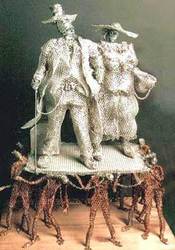Museum of Science and History Exhibits
A Slave Ship Speaks: The Wreck of the Henrietta Marie Exhibition at Fort Worth Museum of Science & History
Selections from Forgotten Heritage were on exhibition with the Henrietta Marie Exhibit at Fort Worth Museum of Science & History and Spirit Square, Charlotte, North Carolina.
School teacher & writer, Edie Scott, wrote the following story for Fort Worth Weekly
CONGO-BORN ARTIST AUGIE KUYOWA N'KELE TELLS THE STORY OF HUMAN BONDAGE THROUGH GRAPHIC FIGURES
The slave trade was big business. For three hundred years, from the 15th to the 19th century, humans were bought and sold as cheap labor to harvest the wealth of the new world. Everyone had a hand in it-England, France, Spain, Belgium, Africa. Queen Elizabeth I invested, as did our nation's father. As late as 1860 there were 850 slaves in the Tarrant county (Texas) area.
A Slave Ship Speaks: The Wreck of the Henrietta Marie...(on exhibit in 1997) at the Fort worth Museum of science and history, describes the slave trade circuit. European manufactured goods-pewter, glass beads, guns and alcohol-were exported to Africa and traded for ivory, spices and slaves. The slave cargo was then sailed to the Caribbean across the Atlantic, a voyage termed the Middle Passage. Slaves who survived were sold and traded for sugar and indigo.
Part of the largest migration in history, the reluctant immigrants brought with them their oral traditions and their art.
.
Artist Augie Kuyowa N'Kele, a native of Congo, has been telling the story of the slave trade since 1991 when he was inspired to take up sculpting. With little formal training, (in sculpting, he has a BA, emphasis painting) he devised a unique method of twisting gutter guard, wire screen and galvanized wire strands into human forms which he arranges to create three dimensional scenes. His art work, included in the the Henrietta Marie exhibit, is part of a body of work N'Kele has entitled "Forgotten Heritage...He described his work in an effort to educate children about the history of slavery.
It's an effective medium for storytelling. As a teacher in a predominantly African American third grade class, I struggled with my students' aversion to their history. As they put it, they didn't want to listen to "all that slave stuff." But the children who watched N'Kele create one of his sculptures, listened attentively to him...
N'Kele's African scenes illustrate (these people) " had a nice life before they were captured. They didn't just show up here, on our shores."
N'Kele bases his dioramas on images he gleans from his avid study of history. "King Alvaro inspired by a 17th century engraving of a Dutch ambassador's visit to a Congo king, portrays an African chief being petitioned by three kneeling men. The bejeweled chief sits protected by two boot clad guards. Hanging above the chief's head is a chandelier, an anachronism which suggests the king has previously traded with Europeans, probably for slaves.
.
N'Kele's work is predominantly realistic. The strongest piece in this exhibit, Slavery I," is a departure from realism which N'Kele described as "symbolic realism." Eleven...slaves lift a platform (of privilege) that supports two obese, obviously wealthy people-a man and a woman. The slaves are small and gaunt, twisted and crumpled under the weight of their burden. The man's fat-cat opulence and woman's graphically detailed breasts embody the obscenity of profiting through the enslavement of human beings.
.
Augie N'Kele's sculptures depict the human cost of slavery and enhance the exhibit's heavily text-based presentation...Edie Scott ............................Reprinted from: Fort Worth Weekly, Nov. 20, 1997
Above: Slavery
Below: King Alvaro

